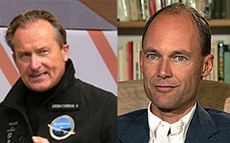Solar Impulse lands after completing round-the-world trip
27 Jul 2016
A 63-year-old former Swiss Air Force pilot and a hypnotherapist five years his junior with a penchant for hot-air balloon exploration completed a round-the-world trip in a solar-powered airplane, predicting that within a decade, commercial flights with electric aircraft will become a reality.
 | |
| Swiss entrepreneur and engineer Andre Borschberg (l) and Swiss psychiatrist and balloonist Bertrand Piccard |
Bertrand Piccard, 58, touched down in his Solar Impulse at 4:05 am in Abu Dhabi, completing the final leg of a 16-month multistage journey, the project team said in a statement Tuesday. The plane has flown 43,041 kilometres since starting the trip in March 2015.
''I'm sure that within 10 years, we'll see electric airplanes transporting 50 passengers on short- to medium-haul flights,'' Piccard said in the statement. ''But it's not enough. The same clean technologies used on Solar Impulse could be implemented on the ground in our daily life.''
Piccard took turns at the controls with Andre Borschberg to circumnavigate the globe without using any fuel. Each pilot was allowed 10 20-minute naps over the course of 24 hours, and the longest leg took five days.
Solar Impulse flew near the Statue of Liberty and Egypt's pyramids for photo opportunities and was grounded for more than half a year in Hawaii due to battery overheating along the way (See: Solar Impulse 2 to resume round-the-world flight).
If the journey was not continuous, it was more to meet the needs of the pilots than those of the plane, which, with an elaborate combination of solar cells and lithium batteries, can fly day and night.
Swiss state-backed clean-energy company Masdar had said at the launch of the mission that the Solar Impulse 2 will attempt its historic journey in March. Bertrand Piccard and Andre Borschberg, the project's founders and pilots, hope to complete the journey over four or five months, including stopovers.
 The Solar Impulse 2 is powered by some 17,200 solar cells arrayed on wings that span 72 metres (236 feet). It is a larger version of a single-seat prototype that first flew five years ago. The founders say the plane in theory can stay airborne indefinitely (Solar Impulse 2 in Spain after 3-day Atlantic crossing).
The Solar Impulse 2 is powered by some 17,200 solar cells arrayed on wings that span 72 metres (236 feet). It is a larger version of a single-seat prototype that first flew five years ago. The founders say the plane in theory can stay airborne indefinitely (Solar Impulse 2 in Spain after 3-day Atlantic crossing).
''There is so much potential for the aeronautical world,'' Borschberg said. ''While 100 per cent solar-powered airplanes might take longer to materialise, electric airplanes will develop in the near future.''
The pilots have been promoting the aircraft, which is made of ultralight materials and relies on 12,000 solar panels for power, as a symbol of options for alternative energy to stave off global warming. Piccard said that he wants Solar Impulse to revive interest in promoting clean technology.
''When you speak of climate change, it is so boring for everybody,'' Piccard said in an interview on Bloomberg TV. ''Everybody knows it is a disaster, so why continuously repeat it? Now you have to give hope to people with real solutions, and they exist,'' and ''my hope is that people finally make a list of solutions rather than a list of problems.''













.jpg)






.jpg)









